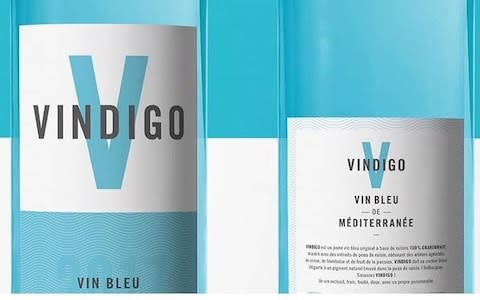Allez le bleu! France becomes a land of red, white and now blue wine

France has just become a country of red, white and now blue wine with the launch of a completely natural, turquoise-coloured variety of its favourite tipple.
Blue Nun may be a total no-no in the land of Chateau Lafite but a wine sold "in the colours of the sea" is now on sale in Sète, a port city in the South of France.
The 100 per cent natural wine begins life as a traditional white but gets its blue tinge after being passed through a pulp of red grape skin thanks to the natural pigment anthocyanin.
It required stiff resolve, however, for blue wine to gain a foothold in famously traditional France, where wine is viewed as a cultural heritage and which resisted the lure of arriviste rosé for more than a century.
Gallic entrepreneur René Le Bail had to shift production to more laisser-faire Spain after his fellow countrymen refused to make his wine.

Now he is triumphantly selling the Almeira-made drink in his homeland but still dreams of convincing a local vineyard to take the plunge, grow his grapes, and make the wine officially French.
Some 35,000 bottles of Vindingo, a chardonnay selling for about 12 euros (£10.70 a bottle), are already on sale in Sète but it will soon be making inroads into the wine capital region of Bordeaux.
Mr Le Bail said that the sales had already surpassed the forecasts of his company, Mediterra Vin.
The fragrant wine has a sweet, mild taste making it a popular aperitif or cocktail drink and it would pair well with seafood such as oysters.
“Women appreciate it very much, said Mr Le Bail, “It is an ideal wine for the summer, to drink on the sand or at the edge of the swimming pool.”
A post shared by Imajyne a Blue Wine (@imajynebluewine) on Jul 15, 2018 at 8:04am PDT
“As soon as it enters the mouth, we have cherry aromas," Mr Le Bail told Belgian Les Echos, adding that it also had notes of blackberry and passion fruit.
Mr Le Bail's order book is bulging with requests from Britain, China, Indonesia, Italy and Belgium.
Blue wine is already available in Spain and on the French island of Corsica but it is making its first serious in-roads into mainland and mainstream French wine culture.
It has split critics, with some insisting that Caribbean island liquor curacao should remain the only blue alcoholic drink.

Mr Le Bail will have to tread carefully on home soil.
Southern French vintners are notoriously hot-tempered about the sale of Spanish-made wine in a region awash with local produce.
They have been known to empty entire tankers of Spanish plonk into French streets to vent their fury at what they see as unfair competition from neighbouring winemakers.
In early July, fraud investigators said they suspected that 10 million bottles of cheap Spanish rosé were illegally sold as more expensive French wine.

 Yahoo News
Yahoo News 
